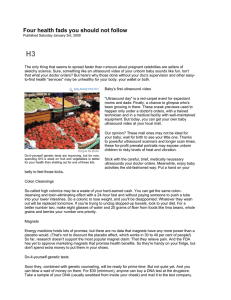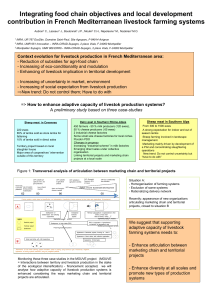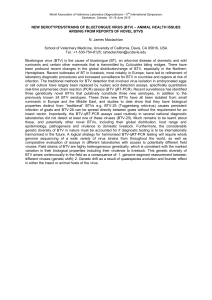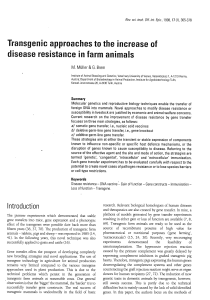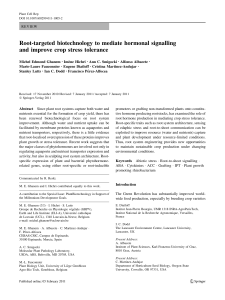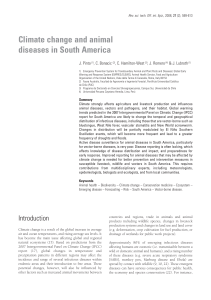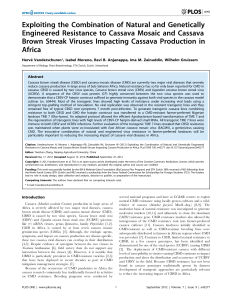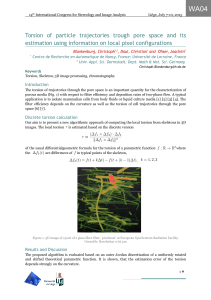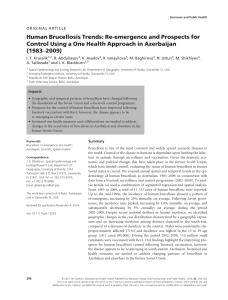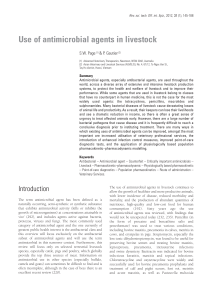D1949.PDF
publicité
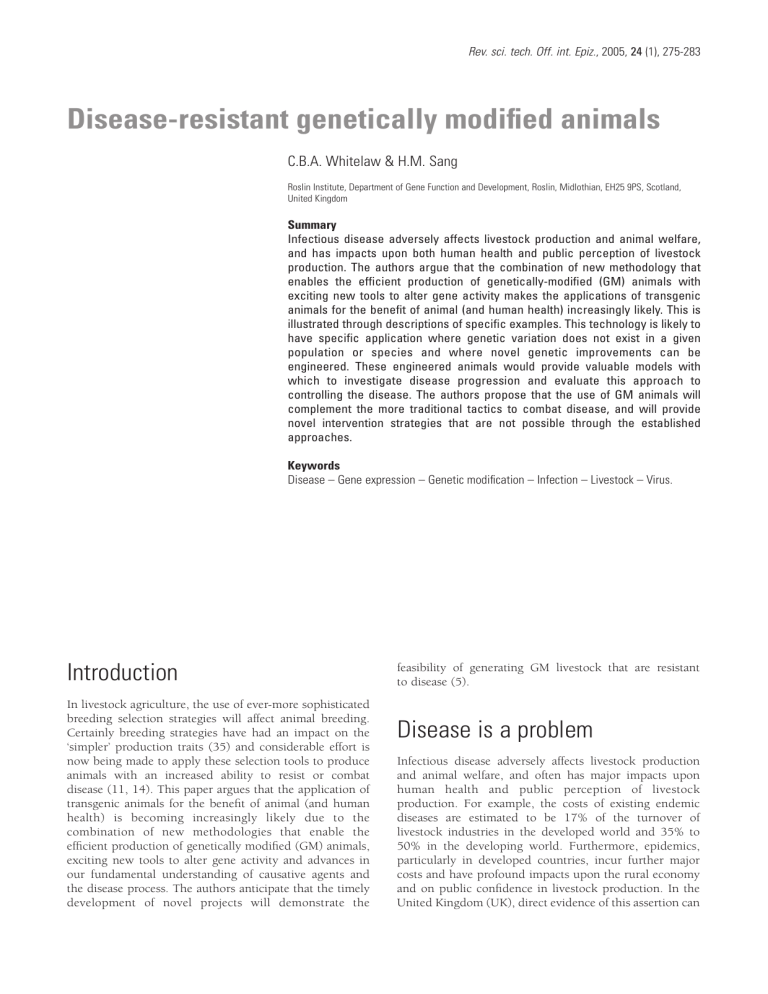
Rev. sci. tech. Off. int. Epiz., 2005, 24 (1), 275-283 Disease-resistant genetically modified animals C.B.A. Whitelaw & H.M. Sang Roslin Institute, Department of Gene Function and Development, Roslin, Midlothian, EH25 9PS, Scotland, United Kingdom Summary Infectious disease adversely affects livestock production and animal welfare, and has impacts upon both human health and public perception of livestock production. The authors argue that the combination of new methodology that enables the efficient production of genetically-modified (GM) animals with exciting new tools to alter gene activity makes the applications of transgenic animals for the benefit of animal (and human health) increasingly likely. This is illustrated through descriptions of specific examples. This technology is likely to have specific application where genetic variation does not exist in a given population or species and where novel genetic improvements can be engineered. These engineered animals would provide valuable models with which to investigate disease progression and evaluate this approach to controlling the disease. The authors propose that the use of GM animals will complement the more traditional tactics to combat disease, and will provide novel intervention strategies that are not possible through the established approaches. Keywords Disease – Gene expression – Genetic modification – Infection – Livestock – Virus. Introduction In livestock agriculture, the use of ever-more sophisticated breeding selection strategies will affect animal breeding. Certainly breeding strategies have had an impact on the ‘simpler’ production traits (35) and considerable effort is now being made to apply these selection tools to produce animals with an increased ability to resist or combat disease (11, 14). This paper argues that the application of transgenic animals for the benefit of animal (and human health) is becoming increasingly likely due to the combination of new methodologies that enable the efficient production of genetically modified (GM) animals, exciting new tools to alter gene activity and advances in our fundamental understanding of causative agents and the disease process. The authors anticipate that the timely development of novel projects will demonstrate the feasibility of generating GM livestock that are resistant to disease (5). Disease is a problem Infectious disease adversely affects livestock production and animal welfare, and often has major impacts upon human health and public perception of livestock production. For example, the costs of existing endemic diseases are estimated to be 17% of the turnover of livestock industries in the developed world and 35% to 50% in the developing world. Furthermore, epidemics, particularly in developed countries, incur further major costs and have profound impacts upon the rural economy and on public confidence in livestock production. In the United Kingdom (UK), direct evidence of this assertion can 276 be seen in the cases of bovine spongiform encephalopathy and the recent foot and mouth disease virus (FMDV) outbreak. Disease affects the sustainability and competitiveness of a community, and animal disease also has many effects on human health, for example: – food safety is compromised when food is contaminated with infectious pathogens and with chemicals used to control and treat infections – antibiotic resistance may arise from the excessive and inappropriate use of antibiotics – zoonotic infections are often harboured by domestic livestock (as is seen in the global effect of influenza). Disease arises as a consequence of infection in the host animal by an infectious agent. Infectious agents include entities such as prions for transmissible spongiform encephalopathies; microparasitic pathogens such as viruses, bacteria or protozoa; or macroparasites such as helminths or nematodes. To control disease effectively requires an understanding of the host-pathogen interaction for that particular disease. Current major advances in gene transfer technologies, in parallel with the significant new genetic information provided by genomic technologies, have made it possible to investigate the host-pathogen interaction in more detail than ever before. Major advances in our understanding of disease are likely to be achieved within the next few years. These technologies will lead to new opportunities for diagnosis, intervention and the selective breeding of animals for resistance. The combination of advanced gene transfer technologies and traditional disease control measures, should allow for more effective and sustainable disease control. How can we combat disease? Disease control strategies focus on either the pathogen or the host. Traditionally, control of animal disease has involved the destruction of the pathogen or the vector carrying the pathogen, e.g. through vaccination, treatment with antibiotics and other drugs, and spraying swamps with dichlorodiphenyltrichloroethane (DTT) to kill mosquitoes. Disease can also be controlled through culling. This latter approach requires defined animal populations, as in the replacement of the sheep population in Iceland to eradicate scrapie, and substantial political support to cover the huge financial burden involved; the recent slaughter campaign to eradicate FMDV from the UK may serve as an example of such costs. Rev. sci. tech. Off. int. Epiz., 24 (1) Despite the success of these traditional strategies in combating specific diseases, there are many continuing challenges relating to animal health and disease. Many previously-used control strategies, e.g. antibiotic use, are now less available due to legislation, or because the pathogen has evolved in such as way that the control strategy is no longer effective, as in the case of antibiotic or anthelmintic resistance. Furthermore, new issues arise continually, and some disease control problems simply remain unsolved. As an alternative to traditional approaches, powerful genetic tools are becoming available to assist in the fight against disease. Ever since humans first domesticated wild species of herbivores a few thousand years ago, they have been genetically modifying these species for their own purposes indirectly through selection. To a large extent, the huge differences between today’s livestock and their progenitors are testament to how successful selective improvement has been. Until relatively recently, this form of genetic improvement was done without any knowledge of the underlying mechanisms. Animals were selected on observable phenotype. Now, with the advent of molecular tools that enable the genetic nature of the desirable trait to be distinguished, a directed approach to the genetic improvement of livestock is possible. Sophisticated statistical and computing tools now enhance conventional genetic selection (35), although traits such as fertility and disease resistance have still proved difficult to measure and improve. Although robust and successful, conventional breeding is limited in that animals produced by mating two selected individuals are a genetic mixture of the two parents. Thus, unknown or undesirable traits can be co-selected inadvertently. In addition, only those genetic loci present in the parent can be selected, which severely limits the range and extent of genetic improvement. Gene addition through transgenic technology potentially offers a route to overcome these limitations. Genetic modification offers alternative strategies to traditional animal breeding. This technology is likely to have specific application where genetic variation does not exist in a given population or species and where novel genetic improvements can be engineered. With either approach, the intention would be to enhance the ability of the animals to mount an appropriate immune response against the pathogen (which could require dampening down the immune system at strategic stages) or to generate an effective system that would directly block pathogen entry or directly destroy the pathogen. Indeed, a combination of strategies may prove to be the most successful approach. The strategy of improving the immune response (a new strategy for which experimental examples are only now being tested) could be used in instances where specific gene alleles that confer resistance are present in a species Rev. sci. tech. Off. int. Epiz., 24 (1) but have been lost from commercial populations. The Mx genes of vertebrates were first discovered in mice because of the ability of functional alleles to induce a potent antiviral state in response to infection by specific groups of viruses, including influenza. Chickens also have an Mx gene, but the allele present in most commercial lines is apparently not functional, due to a single amino acid substitution (16). It is anticipated that many more examples like this will be identified. Indeed, even when a desirable allele is present in a non-mainstream population, it may prove difficult to introduce into a given genotype due to the co-introduction of many unrelated traits, which is a consequence of breeding strategies. The authors propose that incorporation of this type of genetic natural variation into commercial breeding populations would be a productive use of genetic modification technology. Perhaps even more exciting is the potential of GM technology to allow novel genetic traits to be generated. In this scenario the introduced trait would not be normally found in nature; the aim, however, would be to mimic or interfere with specific aspects of the infectious agent. There are various possible strategies, as listed below, and the authors anticipate that current efforts in disease biology will enable more to be devised; for some strategies there is preliminary data to encourage further exploration of this use of GM technology: a) Dominant-negative proteins: the introduction of mutant versions of key factors in pathogen infection, such as cell surface receptors, can block disease progression (33) b) Ribonucleic acid interference (RNAi): this strategy relies on the ability of specific short RNA sequences to anneal with the RNA of the pathogen, causing destruction of the foreign RNA. RNAi requires access to the target RNA, which may limit this approach to viruses (5, 27, 43) c) Ribonucleic acid decoys: expression of RNA sequences that mimic specific sequences within a pathogen can disrupt the activity of the pathogen’s replication machinery (23, 42). Again, this approach is probably restricted to specific viruses, with influenza being a good candidate d) Antibodies: the transgenic production of antibodies in the host animal may act in an analogous manner to vaccination (17, 26, 39). Disease-resistant genetically modified farm animals Genetically modified animals resistant to disease could be used by our society in two ways. First, these engineered animals would provide valuable models with which to investigate disease progression and evaluate this approach 277 to controlling the disease. In this scenario, it is likely that important information relevant to human disease may also be indirectly found. Alternatively, the GM disease-resistant animal could be introduced into the breeding stock. To propose such an introduction is controversial, as it would result in GM animals entering the food chain. However, this issue needs to be discussed; the technology is in place to generate these animals now and the authors believe that some animal diseases justify its use. To demonstrate current thinking in this area specific illustrations are provided below. Foot and mouth disease virus is probably the most contagious mammalian virus and can cause economic losses measured in billions, rather than millions, of dollars. Depending on where you are in the world, this virus is either an endemic problem or a potential serious epidemic disease (9); the ‘stamping-out’ policy associated with the serious 2001 UK outbreak led to at least 6 million animals being slaughtered, most of whom were probably entirely healthy. Several issues restrict our ability to combat FMDV (40). Vaccination and slaughter have classically been used to control animal virus diseases. The FMDV vaccine is effective, but was discontinued in the European Union as a result of cost-benefit analysis. The problems with using FMDV vaccines are well documented: biosecurity in production/innocuity testing, the need for frequent administration, and the effects upon trade of the presence of antibodies in animals. Disease caused by a related virus, poliovirus, is very effectively controlled by routine vaccination – even though issues of concern are appearing with regard to this successful programme (28) – but it is not as simple for FMDV for several reasons. First, there are seven serotypes and many strains of FMDV, whereas there are only three serotypes of poliovirus. In addition, a range of target species can be affected (such as cattle, sheep and pigs). Second, a single administration of the live, attenuated, poliovirus vaccine confers life-long immunity, whereas administrations of the killed, inactivated, FMDV vaccine are required throughout the life of cattle to maintain protective antibody levels. Unlike poliovirus vaccination, FMDV vaccination does not use a live, attenuated strain of the virus, and highly pathogenic FMDV needs to be grown in bulk for vaccine preparation, with obvious attendant biosecurity risks. If an outbreak occurs, contingency or ‘ring’ vaccination has the major drawback of the time-lag before a protective barrier of immune animals is created. Following vaccine administration it takes seven to ten days for a protective immune response to be mounted; thus ‘ring-fence’ vaccination might not have contributed substantially to halting the recent devastating epidemic in the UK (15). On a number of grounds, mass slaughter is becoming socially unacceptable and will be increasingly 278 difficult to implement effectively. Taken together, these issues indicate an acute need for new approaches to combat FMDV infection and the authors have suggested that RNAi might be the strategy of choice. If successful, such an RNAi strategy would be equally applicable to a range of other highly significant virus pathogens; RNA viruses comprise over two-thirds of the OIE list-A pathogens. Encouragingly, early experiments in a mouse model (3) support this claim. Another candidate for RNAi strategies is Marek’s disease (MD) in chickens, which is caused by a herpesvirus and has traditionally been controlled by the widespread use of live attenuated vaccines. However, this intervention strategy has not been able to prevent the evolution of a more virulent MD virus, with concomitant increases in disease severity (1). Therefore, there is again an urgent need to develop new approaches for MDV control, and strategies using RNAi may prove productive. Human influenza virus is notorious for its ability to repeatedly re-assort, using genome segments with those from avian or swine influenza viruses (21). The effect can be devastating; more people died of Spanish influenza in 1918 than died in the preceding World War! Today, the spread of new influenza viruses on a global scale will occur extremely rapidly (31, 45). Despite the availability of effective vaccines and antiviral drugs, combined with integrated surveillance networks, it is unlikely that the international community could prevent a global epidemic with potentially devastating consequences and highly virulent new influenza virus strains. This risk is ever present, as demonstrated by the 1997 Hong Kong epidemic and the ongoing outbreak in Holland. Central to this cycle of virus evolution are domestic species such as pigs and chickens. Therefore, strategies that target these species could have a dramatic effect in reducing the risk of influenza epidemics. In this regard, two RNA-based approaches may prove useful. Studies in mice have demonstrated the feasibility of using RNAi approaches (8, 44), while the specific viral genome structure and replication requirements make RNA-decoys a likely proposition. Rev. sci. tech. Off. int. Epiz., 24 (1) – dominant-negative versions of virus receptors, which are an appealing option and have been shown to prevent pseudorabies infection in mice (33). To date, these strategies are largely restricted to mouse models, with very few transgenic farm animal studies being attempted; one of the first was an attempt to make pigs resistant to influenza virus by transgenically enabling the animals to express Mx proteins (30). The potentially powerful beneficial effect of expressing a murine Mx gene in the chick, conferring resistance to influenza infection, has been demonstrated in cell culture experiments (7). However, to date there has been a failure to transfer these exciting ideas to practical techniques for livestock; the few pioneering GM livestock studies were not able to generate disease-resistant animals. The main reason for the lack of progress in livestock is primarily the cost involved in generating transgenic livestock and birds. This in turn is primarily due to the inefficiency of current methods of transferring genes into farm animals. The paper will now describe how this limitation has been largely overcome for some applications, and propose that a new era in GM livestock and birds is emerging. Are we limited by technical inefficiency? Transgenic animals carry a segment of foreign deoxyribonucleic acid (DNA) – the transgene – inserted in their germline, which is inherited in a Mendelian fashion. The first transgenic livestock were generated two decades ago using the pronuclear injection method (10). More recently, nuclear transfer techniques (2, 48) have been adapted for making transgenic livestock that allow more precise modifications, such as the disruption of a specific endogenous gene (6, 24). However, attempts to generate GM birds such as chickens have proved technically demanding (36), and on the whole, the techniques for generating transgenic livestock and birds, as described below, are inefficient and expensive. Pronuclear injection The authors have used these two examples to justify the use of GM animals. There are other possibilities that also deserve consideration, such as: – the use of animals engineered to produce antibodies in milk that confer passive immunity to offspring, for example against coronavirus infection (17, 39) – the use of dominant-negative proteins for the treatment of human immunodeficiency virus infection, if this technique could be combined with an effective method of gene transfer (22) Pronuclear injection, a technique developed in the mouse, which involves direct introduction of a DNA construct into one of the two pronuclei of the fertilised egg, was the technique used to produce the early transgenic livestock (10, 3). However the efficiency of this method is low: usually only 3% to 5% of the animals born carry the ‘transgene’. Nevertheless, it is a robust technique and it has been used to develop the animal bioreactor concept whereby animals are engineered to produce pharmaceutical proteins in their milk (4, 48, 50). 279 Rev. sci. tech. Off. int. Epiz., 24 (1) Gene targeting Pronuclear injection enables only the random addition of genes to the germline. It does not allow the precise modification of the germline required for the specific deletion or modification of endogenous genes. In the mouse, techniques for knocking out genes were established during the 1980s (38). In this approach endogenous genes are targeted by homologous recombination in totipotent embryonic stem (ES) cells in culture. These cells are then re-introduced into the early embryo to colonise the tissues of the developing mouse. Unfortunately, despite intensive effort, this technology is limited to the mouse, as no germline-competent ES cells have been described for any other mammalian species (41). The reason for this lack of success is unclear, and certainly does not reflect the massive amount of effort that has been directed towards this goal for over a decade. In some quarters, there is the hope that, as a result of the experience gained through the isolation and maintenance of human ES cells, new efforts to generate ruminant ES cells may be more productive. The advent of cloning by nuclear transfer from somatic cells (2, 49) offered an alternative solution. Endogenous genes in somatic cells can be targeted by homologous recombination in much the same way that this is done in mouse ES cells. Nuclei can be transferred from these targeted cells to enucleated oocytes in cloning experiments. The first report of a cloning strategy being used to generate transgenic livestock described the replacement of the sheep collagen gene with an expression cassette designed to target the expression of human factor IX to milk (24). The second report described the generation of a lamb carrying a disruption of the PrP gene (6), which determines resistance to scrapie and BSE; subsequent studies are generating cattle that lack this gene (19). This method has also allowed the transfer of large DNA fragments (18). However, the very few successes that have been reported using the nuclear transfer approach highlights just how technically demanding it is. recovered from laying hens shortly after fertilisation can be injected with transgene constructs and cultured to give hatched chicks, 1% of which will be transgenic (37). It is easy to obtain fertile new-laid eggs, but as development of the embryo is advanced at the time of laying, attempts to genetically modify embryos at this stage result in production of chimeric animals that may not have transgenic germline cells. The greatest successes in the production of transgenic birds have been achieved using vectors derived from avian retroviruses. Different retroviral vectors have been developed, with the highest success achieved by using a vector derived from spleen necrosis virus, where one transgenic male is identified from 15 potential transgenics (29). The use of avian virus vectors has technical problems associated with poor levels of expression of transgenes carried by the vectors and potential high risks of recombination with retroviruses that are prevalent in commercial poultry populations. These problems may be overcome by the use of lentiviral vectors, as discussed below. New methods There have been numerous recent developments in animal transgenesis. Some – such as sperm-mediated gene transfer (20), especially if combined with intracytoplasmic-sperm injection (32) – are appealing, but still lack the robust character needed to attract more general interest. In the opinion of the authors, the most encouraging development with respect to the genetic modification of livestock relates to the use of viral vectors, particularly those based on lentiviruses (12, 13, 25, 34, 46, 47), that offer a solution to current limitations through dramatic increases in efficiency. This use of this type of vector-delivery of transgenes may mark the beginning of a new era in transgenic livestock simply by reducing the cost involved in their generation. Techniques for the production of transgenic birds The future for genetically modified farm animals There are significant differences between the reproductive physiology of birds and mammals, which have made it impossible to directly apply methods of genetic modification developed for mammals to the production of transgenic birds. Avian embryos develop from a very large yolky egg that is enveloped in a hard shell after fertilisation and then incubated. By the time a fertile egg is laid, the chick embryo has already developed to a stage at which the embryo consists of approximately 60,000 cells. Despite the technical challenges, several methods are being developed that have been successful to some extent (36, 51). Zygotes In the UK, the FMDV and BSE crises have demonstrated how seriously public confidence and the rural economy can be affected by outbreaks of animal disease. Other, less prominent diseases of livestock are also of concern because of their effect on human health, animal welfare and/or the economics of livestock production. There is a need to reexamine the best ways of controlling disease outbreaks in farm animals, not just in the case of the diseases that have captured the headlines but across the board. Perhaps the most important targets are those endemic diseases that blight the economy and society of developing countries. 280 Rev. sci. tech. Off. int. Epiz., 24 (1) Diseases in farm animals can be controlled by vaccination, the use of drugs, improved husbandry and by breeding animals for improved resistance. Successful management of disease is likely to include a combination of approaches. The authors propose that the use of GM animals will complement these more traditional tactics, and provide novel intervention strategies that are not possible through the established approaches. They do not anticipate that GM will be the primary tool in the fight against disease, but rather that its use will be restricted to specific diseases. Encouragingly, experimental results from model systems indicate that GM strategies can work (3, 8, 17, 44). Study of the host-pathogen interaction is growing rapidly since it is seen as a major area for the fruitful application of genomics, particularly in North America and Western Europe. Research worldwide into host-animal responses to infectious disease is fragmented. The capacity to genetically modify farm animals is restricted to a few countries, indeed to only a few laboratories in these countries. More cooperation is required, and the decisionmaking bodies have to find the confidence to support what is both an exciting scientific frontier and one that may bring huge benefit to animals and humans through combating disease. Animaux génétiquement modifiés résistants à certaines maladies C.B.A. Whitelaw et H.M. Sang Résumé Les maladies infectieuses ont des conséquences néfastes pour l’élevage et le bien-être animal et influent à la fois sur la santé humaine et sur la perception du public quant à la production animale. Les auteurs affirment que les nouvelles méthodologies qui permettent la production efficiente d’animaux génétiquement modifiés (GM), associées aux nouveaux outils prometteurs visant à modifier l’activité des gènes, accroissent de plus en plus les probabilités d’applications des animaux transgéniques au service de la santé animale (et de la santé humaine). La description d’exemples spécifiques illustre ce propos. Cette technologie a toutes les chances de trouver une application spécifique quand la variation génétique est absente au sein d’une population ou d’une espèce donnée et quand de nouvelles améliorations génétiques peuvent être produites. Ces animaux issus du génie génétique fourniront des modèles utiles permettant d’étudier l’évolution de la maladie et d’évaluer cette approche appliquée au contrôle des maladies. Les auteurs estiment que les animaux GM seront utilisés en complément des mesures plus traditionnelles prises pour combattre une maladie et représenteront de nouvelles stratégies d’intervention que ne permettent pas les méthodes en vigueur. Mots-clés Élevage – Expression des gènes – Infection – Maladie – Modification génétique – Virus. 281 Rev. sci. tech. Off. int. Epiz., 24 (1) Animales modificados genéticamente resistentes a las enfermedades C.B.A. Whitelaw & H.M. Sang Resumen Las enfermedades infecciosas perjudican la producción ganadera y el bienestar de los animales, influyen en la salud humana y animal y modifican la imagen de la producción pecuaria ante la opinión pública. Los autores postulan que la combinación de nuevos métodos para generar con gran eficiencia animales modificados genéticamente y de las nuevas y prometedoras herramientas para modificar la actividad génica, hace cada vez más probable que se utilicen animales transgénicos en beneficio de la salud animal (y también humana), extremo que ilustran con varios ejemplos concretos. Es probable que esta tecnología tenga aplicaciones específicas cuando una población determinada no presente variación genética o cuando puedan obtenerse por ingeniería mejoras genéticas novedosas. Estos animales obtenidos por ingeniería genética ofrecerían interesantes modelos con los que analizar la progresión de ciertas enfermedades y evaluar este tipo de soluciones para combatirlas. Los autores predicen que el uso de animales modificados genéticamente vendrá a complementar los métodos convencionales de lucha zoosanitaria y traerá consigo estrategias originales de intervención que hasta la fecha, con los planteamientos al uso, no resultaban factibles. Palabras clave Enfermedad – Expresión génica – Ganado – Infección – Modificación genética – Virus. References 1. Baaten B.J., Butter C. & Davison T.F. (2004). – Study of hostpathogen interactions to identify sustainable vaccine strategies to Marek’s disease. Vet. Immunol. Immunopathol., 100 (3-4), 165-177. 2. Campbell K.H., McWhir J., Ritchie W.A. & Wilmut I. (1996). – Sheep cloned by nuclear transfer from a cultured cell line. Nature, 380 (6573), 64-66. 3. Chen W., Yan W., Du Q., Fei L., Liu M., Ni Z., Sheng Z. & Zheng Z. (2004). – RNA interference targeting VP1 inhibits foot-and-mouth disease virus replication in BHK-21 cells and suckling mice. J. Virol., 78 (13), 6900-6907. 4. Clark A.J., Bessos H., Bishop J.O., Brown P., Harris S., Lathe R., McClenaghan M., Prowse C., Simons J.P., Whitelaw C.B.A. & Wilmut I. (1989). – Expression of human anti-hemophilic factor IX in the milk of transgenic sheep. Biotechnology, 7, 487-492. 5. Clark J. & Whitelaw B. (2003). – A future for transgenic livestock. Nat. Rev. Genet., 4 (10), 825-833. 6. Denning C., Burl S., Ainslie A., Bracken J., Dinnyes A., Fletcher J., King T., Ritchie M., Ritchie W.A., Rollo M., de Sousa P., Travers A., Wilmut I. & Clark A.J. (2001). – Deletion of the α(1,3) galactosyl transferase (GGTA1) gene and the prion protein (PrP) gene in sheep. Nature Biotechnol., 19 (6), 559-562. 7. Garber E.A., Chute H.T., Condra J.H., Gotlib L., Colonno R.J. & Smith R.G. (1991). – Avian cells expressing the murine Mx1 protein are resistant to influenza virus infection. Virology, 180 (2), 754-762. 8. Ge Q., McManus M.T., Nguyen T., Shen C.H., Sharp P.A., Eisen H.N., Chen J. (2003). – RNA interference of influenza virus production by directly targeting mRNA for degradation and indirectly inhibiting all viral RNA transcription. Proc. natl Acad. Sci. USA., 100 (5), 2718-2723. 9. Grubman M.J. & Baxt B. (2004). – Foot-and-mouth disease. Clin. Microbiol. Rev., 17 (2), 465-493. 282 10. Hammer R.E., Pursel V.G., Rexroad C.E., Wall R.J., Bolt D.J., Ebert K.M., Palmiter R.D. & Brinster R.L. (1985). – Production of transgenic rabbits, sheep and pigs by microinjection. Nature, 315 (6021), 680-683. 11. Hanotte O., Ronin Y., Agaba M., Nilsson P., Gelhaus A., Horstmann R., Sugimoto Y., Kemp S., Gibson J., Korol A., Soller M. & Teale A. (2003). – Mapping of quantitative trait loci controlling trypanotolerance in a cross of tolerant West African N’Dama and susceptible East African Boran cattle. Proc. natl Acad. Sci. USA, 100 (134), 7443-7448. 12. Hofmann A., Kessler B., Ewerling S., Weppert M., Vogg B., Ludwig H., Stojkovic M., Boelhauve M., Brem G., Wolf E. & Pfeifer A. (2003). – Efficient transgenesis in farm animals by lentiviral vectors. EMBO Reports, 4 (11), 1054-1060. 13. Hofmann A., Zakhartchenko V., Weppert M., Sebald H., Wenigerkind H., Brem G., Wolf E. & Pfeifer A. (2004). – Generation of transgenic cattle by lentiviral gene transfer into oocytes. Biol. Reprod., 71 (2), 405-409. 14. Jorgensen C.B., Cirera S., Anderson S.I., Archibald A.L., Raudsepp T., Chowdhary B., Edfors-Lilja I., Andersson L. & Fredholm M. (2003). – Linkage and comparative mapping of the locus controlling susceptibility towards E. coli F4ab/ac diarrhoea in pigs. Cytogenet. Genome Res., 102 (1-4), 157-162. 15. Keeling M.J., Woolhouse M.E., May R.M., Davies G. & Grenfell B.T. (2003). – Modelling vaccination strategies against foot-and-mouth disease. Nature, 421 (6919), 136142. 16. Ko J.H., Jin H.K., Asano A., Takada A., Ninomiya A., Kida H., Hokiyama H., Ohara M., Tsuzuki M., Nishibori M., Mizutani M. & Watanabe T. (2002). – Polymorphisms and the differential antiviral activity of the chicken Mx gene. Genome Res., 12 (4), 595-601. 17. Kolb A.F., Pewe L., Webster J., Perlman S., Whitelaw C.B.A. & Siddell S.G. (2001). – Virus-neutralizing monoclonal antibody expressed in milk of transgenic mice provides full protection against virus-induced encephalitis. J. Virol., 75 (6), 2803-2809. 18. Kuroiwa Y., Kasinathan P., Choi Y.J., Naeem R., Tomizuka K., Sullivan E.J., Knott J.G., Duteau A., Goldsby R.A., Osborne B.A., Ishida I. & Robl J.M. (2002). – Cloned transchromosomic calves producing human immunoglobulin. Nature Biotechnol., 20 (9), 889-894. 19. Kuroiwa Y., Kasinathan P., Matsushita H., Sathiyaselan J., Sullivan E.J., Kakitani M., Tomizuka K., Ishida I. & Robl J.M. (2004). – Sequential targeting of the genes encoding immunoglobulin-µ and prion protein in cattle. Nature Genet., 36 (7), 775-780. 20. Lavitrano M., Bacci M.L., Forni M., Lazzereschi D., Di Stefano C., Fioretti D., Giancotti P., Marfe G., Pucci L., Renzi L., Wang H., Stoppacciaro A., Stassi G., Sargiacomo M., Sinibaldi P., Turchi V., Giovannoni R., Della Casa G., Seren E. & Rossi G. (2002). – Efficient production by sperm-mediated gene transfer of human decay accelerating factor (hDAF) transgenic pigs for xenotransplantation. Proc. natl Acad. Sci. USA, 99 (22), 14230-14235. Rev. sci. tech. Off. int. Epiz., 24 (1) 21. Li K.S., Xu K.M., Peiris J.S., Poon L.L., Yu K.Z., Yuen K.Y., Shortridge K.F., Webster R.G. & Guan Y. (2003). – Characterisation of H9 subtype influenza viruses from the ducks of southern China: a candidate for the next influenza pandemic in humans? J. Virol., 77 (12), 6988-6994. 22. Lori F., Guallini P., Galluzzi L. & Lisziewicz J. (2002). – Gene therapy approaches to HIV infection. Am. J. Pharmacogenomics, 2 (4), 245-252. 23. Luo G., Danetz S. & Krystal M. (1997). – Inhibition of influenza viral polymerases by minimal viral RNA decoys. J. gen. Virol., 78 (Pt 9), 2329-2333. 24. McCreath K.J., Howcroft J., Campbell K.H., Colman A., Schnieke A.E. & Kind A.J. (2000). – Production of genetargeted sheep by nuclear transfer from cultured somatic cells. Nature, 405 (6790), 1066-1069. 25. McGrew M.J., Sherman A., Ellard F.M., Lillico S.G., Gilhooley H.J., Kingsman A.J., Mitrophanous K.A. & Sang H. (2004). – Efficient production of germline transgenic chickens using lentiviral vectors. EMBO Reports, 5 (7), 728733. 26. Marasco W.A. (2001). – Intrabodies as antiviral agents. Curr. Top. Microbiol. Immunol., 260, 247-270. 27. Mello C.C. & Conte D. (2004). – Revealing the world of RNA interference. Nature, 431 (7006), 338-342. 28. Minor P.D. (2003). – Polio vaccines and the cessation of vaccination. Expert Rev. Vaccines, 2 (1), 99-104. 29. Mozdziak P.E., Borwornpinyo S., McCoy D.W. & Petitte J.N. (2003). – Development of transgenic chickens expressing beta-galactosidase. Dev. Dynam., 226 (3), 439-445. 30. Muller M., Brenig B., Winnacker E.L. & Brem G. (1992). – Transgenic pigs carrying cDNA copies encoding the murine Mx1 protein which confers resistance to influenza virus infection. Gene, 121 (2), 263-270. 31. Nicholson K.G., Wood J.M. & Zambon M. (2003). – Influenza. Lancet, 362 (9397), 1733-1745. 32. Niemann H., Rath D. & Wrenzycki C. (2003). – Advances in biotechnology: new tools in future pig production for agriculture and biomedicine. Reprod. dom. Anim., 38 (2), 8289. 33. Ono E., Amagai K., Taharaguchi S., Tomioka Y., Yoshino S., Watanabe Y., Cherel P., Houdebine L.M., Adam M., Eloit M., Inobe M. & Uede T. (2004). – Transgenic mice expressing a soluble form of porcine nectin-1/herpesvirus entry mediator C as a model for pseudorabies-resistant livestock. Proc. natl Acad. Sci. USA, 101 (46), 16150-5. 34. Pfeifer A. (2004). – Lentiviral transgenesis. Transgenic Res., 13 (6), 513-22. 35. Rothschild M.F. (2004). – Porcine genomics delivers new tools and results: this little piggy did more than just go to market. Genet. Res., 83 (1), 1-6. 36. Sang H. (2004). – Prospects for transgenesis in the chick. Mechanisms Dev., 121 (9), 1179-1186. Rev. sci. tech. Off. int. Epiz., 24 (1) 37. Sherman A., Dawson A., Mather C., Gilhooley A., Li Y., Mitchell R., Finnegan D. & Sang H. (1998). – Transposition of the Drosophila element mariner into the chicken germ line. Nature Biotechnol., 16 (11), 1050-1053. 38. Smithies O., Gregg R.G., Boggs S.S., Koralewski M.A. & Kucherlapati R.S. (1985). – Insertion of DNA sequences into the human chromosomal beta-globin locus by homologous recombination. Nature, 317 (6034), 230-244. 39. Sola I., Castilla J., Pintado B., Sanchez-Morgado J.M., Whitelaw C.B., Clark A.J. & Enjuanes L. (1998). – Transgenic mice secreting coronavirus neutralizing antibodies into the milk. J. Virol., 72 (5), 3762-3772. 40. Sutmoller P., Barteling S.S., Olascoaga R.C. & Sumption K.J. (2003). – Control and eradication of foot-and-mouth disease. Virus Res., 91 (1), 101-144. 41. Thomson A.J. & McWhir J. (2004). – Biomedical and agricultural applications of animal transgenesis. Mol. Biotechnol., 27 (3), 231-244. 42. Tiley L.S., Hagen M., Matthews J.T. & Krystal M. (1994). – Sequence-specific binding of the influenza virus RNA polymerase to sequences located at the 5’ ends of the viral RNAs. J. Virol., 68 (8), 5108-5116. 43. Tiscornia G., Singer O., Ikawa M. & Verma I.M. (2003). – A general method for gene knockdown in mice by using lentiviral vectors expressing small interfering RNAs. Proc. natl Acad. Sci. USA, 100 (4), 1844-1848. 44. Tompkins S.M., Lo C.Y., Tumpey T.M. & Epstein S.L. (2004). – Protection against lethal influenza virus challenge by RNA interference in vivo. Proc. natl Acad. Sci. USA, 101 (23), 86828686. 283 45. Webby R.J. & Webster R.G. (2003). – Are we ready for pandemic influenza? Science, 302 (5650), 1519-1522. 46. Whitelaw C.B.A. (2004). – Transgenic livestock made easy. Trends Biotechnol., 22 (4), 157-159. 47. Whitelaw C.B.A., Radcliffe P.A., Ritchie W.A., Carlisle A., Ellard F.M., Pena R.N., Rowe J., Clark A.J., King T.J. & Mitrophanous K.A. (2004). – Efficient generation of transgenic pigs using an equine infectious anaemia virus (EIAV) derived vector. FEBS Lett., 571 (1-3), 232-236. 48. Wilmut I. & Whitelaw C.B.A. (1994). – Strategies for production of pharmaceutical proteins in milk. Reprod. Fertil. Dev., 6 (5), 625-630. 49. Wilmut I., Schnieke A.E., McWhir J., Kind A.J. & Campbell K.H. (1997). – Viable offspring derived from fetal and adult mammalian cells. Nature, 385 (6619), 810-813. 50. Wright G., Carver A., Cottom D., Reeves D., Scott A., Simons P., Wilmut I., Garner I. & Colman A. (1991). – High level expression of active human alpha-1-antitrypsin in the milk of transgenic sheep. Biotechnology, 9 (9), 830-834. 51. Zajchowski L.D. & Etches R.J. (2000). – Transgenic chickens: past, present and future. Avian Poultry Biol. Rev., 11 (2), 63-80.



